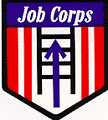|
Job Corps course title: Welding (Metals Technology). Students in this class learn welding techniques with an emphasis on arc, acetylene, gas metal, flux core, and gas tungsten welders. Prepares students for entry level welding in industrial, high tech manufacturing, auto/transportation, construction and maintenance industries.
On the job, combination welders do both arc and gas welding. In arc welding, heat is produced by an electric current. Arc welding is used for large jobs such as fabricated work with heavy plates and large shapes. It is also used in production line and general assembly operations where speed is necessary.
Gas welding is done with a flame combining oxygen and acetylene or oxygen and hydrogen gases and is used for small repairs or delicate jobs on light metals or tubing.
Journey level combination welders perform a variety of welding tasks using manual, semiautomatic, and automatic arc and gas equipment. They work from blueprints, layouts, and work orders. Their job duties include fabrication and repair of machine parts, motors, trailers, and manufacturing equipment. They repair broken parts, fill holes, cut metal, and increase the size of metal parts.
Arc cutters trim and cut metal objects to blueprint, work order, or layout specifications. Using a hand guided torch, they direct the electric arc onto an area of metal. As the metal begins to melt, they cut it along pre-marked lines with arc torches or with a stream of gas flame from thermal torches.
Welders and cutters might work outdoors, exposed to the weather, or inside a confining, poorly- ventilated work area. They may work high off the ground. These workers are exposed to certain work hazards such as falling objects, fumes, smoke, and the possibility of explosions resulting from gases under great pressure and residual gas fumes. Damage to the eyes can result from exposure to intense light created by welding arcs. They are constantly exposed to hot flying metal flecks that can cause skin burns and set fire to clothing. To protect themselves against such hazards, workers wear goggles or welding hoods with special lenses, heavy gloves and other protective clothing.
Routes to advancement vary with the employer, location and type of work. The most common step is from journey-level worker to lead or job-shop supervisor. Some welders who have the necessary capital open job shops of their own. Welders and cutters with the required experience and training may advance to inspector or may become welding instructors.
The long term outlook shows a moderate demand for combination welders. Nationwide, it is expected that there will be a gradual decline for Welders and Cutters through the year 2005. Robotics welding systems have already eliminated some routine cutting and welding jobs.
Santa Clara County
Hourly Wage Ranges |
Low
$8.50 |
High
$21.00 |
To enroll in this San Jose Job Corps Course: 510 TABE Math/Reading score OR GED/HS diploma.
Job specific skills: Often, employers use a pre-employment screening process. It may include on-the-spot written and welding tests, verification of journey level status and proof of certification. Welders must be able to perform a variety of welding tasks using manual, semiautomatic, and automatic arc and gas equipment. They work be able to work from blueprints, layouts, and work orders. They must have good eyesight, manual dexterity and eye-hand coordination. They must often be able to perform physical activity which may include lifting heavy objects and equipment, reaching, walking, climbing, stooping, kneeling, and crawling.
Back to Top
|



